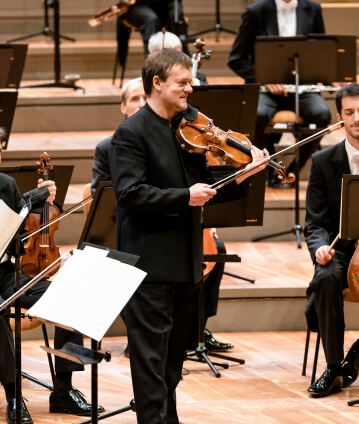Kirill Petrenko and Frank Peter Zimmermann

“Alban Berg’s Violin Concerto is a piece that gets under your skin,” says violinist Frank Peter Zimmermann. Devastated by the death of Manon Gropius, the daughter of Alma Mahler and Walter Gropius, the composer created a musical memorial to the young girl with this work, and at the same time created one of the most poignant concertos of the 20th century. Antonín Dvořák strikes a completely different mood in his Fifth Symphony – one that is cheerful, relaxed and pastoral. The work is dedicated to Hans von Bülow, the first chief conductor of the Berliner Philharmoniker.
Alban Berg’s violin concerto is dedicated “to the memory of an angel”. This particular angel, Manon Gropius, contracted polio at the age of 17 and died a year later. To create a memorial to the much-admired young woman, Berg interrupted work on his opera Lulu. He would not be able to finish the opera, as he himself died shortly after completing the violin concerto: the tribute became his legacy.
Berg was one of the first to apply the twelve-tone technique of his teacher Arnold Schoenberg to a solo concerto – albeit in a less radical form. Berg sought to overlap major-minor harmony and twelve-tone, which intensified the lyrical content of the piece. In the first of the two movements, he paints a portrait of Manon’s multifaceted nature. The music is sometimes lyrical, sometimes rustic and even hints of a Carinthian ländler. In the second movement, the catastrophe of the outbreak of illness (a nine-note fortissimo chord) and the girl’s death are addressed with a variation of the Bach chorale “Es ist genug”. At the end, the solo violin loses itself in the highest notes in a reprisal of the opening bars.
Antonín Dvořák composed his Fifth Symphony in five weeks during the summer of 1875. It was a time when – thanks in part to the support of Johannes Brahms – he was able to slowly free himself from the front line of orchestral duties (he played the viola), his teaching and organist duties, and focus increasingly on composing. The Fifth reflects the composer’s new self-confidence. From the very first bar, a mood often described as “pastoral” emerges, but its ambiguous nature soon becomes apparent. In the andante, the melancholy theme introduced by the cellos, based on the Slavic folk song form of the dumka, is taken up first by the violins and then the woodwinds; the middle section brightens, but the melancholy theme reappears – a simultaneity of opposites. The transition to the scherzo takes place without a break, forming a central element in Dvořák’s endeavour to link all the symphonic movements together. The last movement calls everything into question. For 54 bars, A minor struggles with the home key of F major, and the main theme changes its character: Dvořák was also a dramatist. The resolution only comes at the end, when the trombones unmistakably bring back the pastoral theme of the first movement and so confirm the belief in the idyll.
© 2020 Berlin Phil Media GmbH
Related interviews
Artists
Our recommendations
- Daniel Harding, Frank Peter Zimmermann and Christian Gerhaher
- Alan Gilbert and Frank Peter Zimmermann with Bartók’s First Violin Concerto
- Memorial concert for Claudio Abbado with Simon Rattle and Frank Peter Zimmermann
- Jakub Hrůša and Frank Peter Zimmermann with a Czech evening
- Brahms’s Violin Concerto with Frank Peter Zimmermann and Bernard Haitink
- Alan Gilbert and Frank Peter Zimmermann